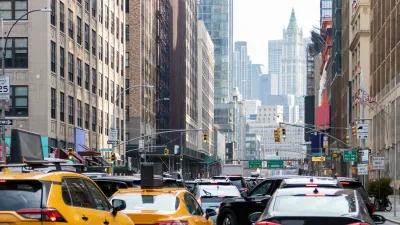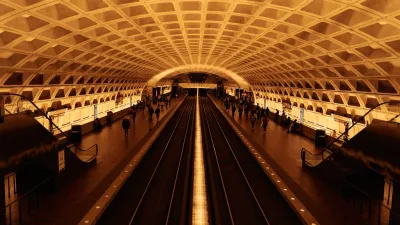It's been a great week for city planning here on the East Coast. The American Planning Association's 99th National Conference held in Philadelphia drew more than 6,000 attendees, a fact noticed by Philadelphia Inquirer writer Inga Saffron in her April 13th column titled "Welcome, Welcome City Planners," where she took the opportunity to draw local and national lessons from the event. The APA opened with Robert Kennedy's address on environmental planning and closed with an exploration of the legacy of Edmund Bacon (Philadelphia's director of city planning from 1949-1970), but more about that later.
It's been a great week for city planning here on the East Coast. The American Planning Association's 99th National Conference held in Philadelphia drew more than 6,000 attendees, a fact noticed by Philadelphia Inquirer writer Inga Saffron in her April 13th column titled "Welcome, Welcome City Planners," where she took the opportunity to draw local and national lessons from the event. The APA opened with Robert Kennedy's address on environmental planning and closed with an exploration of the legacy of Edmund Bacon (Philadelphia's director of city planning from 1949-1970), but more about that later.
By the end of the week on Earth Day, the mayor of the nation's largest city, had outlined his PlaNYC 2030, A Greener, Greater New York, designed to reduce the city's already low carbon footprint by 30%. A standing-room only crowd at the Museum of Natural History (under the great hanging whale) came to hear and applaud Michael Bloomberg. The next morning the city's newspapers trumpeted the plan's details, with the Daily News even providing a green banner headline.
An important theme characterized the week, a common concern with how to plan a city to meet the challenges of the next century. For example, the APA's closing plenary looked at how Bacon transformed a 19th century city into a 20th century place while Bloomberg's address showed how to drag the Big Apple out of the 20th and into the 21st century.
Albeit separated by a half century, the visions had three areas in common: land, transportation and open space/greening. Both contained bold, dramatic moves and smaller incremental projects. For Bacon, the land question revolved around how to create more space in a congested city -- more space for the downtown economy (offices, retail and the arts) and for relieving the crowding in residential neighborhoods. While for Bloomberg, the question is about how to find more space to provide affordable housing. Where Bacon used centrally located but obsolete rail yards and undeveloped acres at the city's periphery, Bloomberg is concentrating on reclaiming brownfieds. decking over outlying highways and rail lines and maximizing government-ownd sites.
Both visionaries have the land use/transportation connection in mind, calling for dense development around key nodes, making multi-modal systems function efficiently while enhancing the pedestrial realm. For Bacon this meant conceiving a complex but seamless arrangements to connect the city center and the region. (He illustrates it beautifully in his classic book Design of Cities, published in 1967). For Bloomberg the answer lies in fixing existing facilities and introducing congestion pricing. Both believe that stategic public investments trigger the private expenditures that will bring their respective cities into the next century.
One area, where surprisingly, given the distance of their eras, they share similar concerns is in urban greening. Little recognized in the contemporary assessments of his work is Bacon's insistence on maximizing nature when it intersects in city life. His most important projects -- Penn Center, Market East, Society Hill and the Northeast are filled with streaming sunlight, greenery (street trees, flowers), small public plazas, creeks and rivers winding through in-town suburban neighborhoods. Here we see the inspiration and foundation of the 21st century vision captured by Bloomberg. For this Wall-Street-wizard-turned-politico the goals are the same but he quantifies them: "we will plant a million trees," we will have a public plaza in each of our 59 community board neighborhoods" and so forth.
While there are differences between the two, there is also a common thread. Bacon had the benefit of major infusions of federal dollars, Bloomberg does not. Bacon never heard of global warming, Bloomberg is tackling it head on. But what they share is leadership -- a capacity to craft and communicate a vision that is grand, aspirational and important. And, they have the will to pursue it doggedly. These are special skills, ones that cut through details to lay out key systems essential for the growth and development of cities. The discovery and celebration of these qualities from the past and the present are what made this a great week for planning on the East Coast.

Alabama: Trump Terminates Settlements for Black Communities Harmed By Raw Sewage
Trump deemed the landmark civil rights agreement “illegal DEI and environmental justice policy.”

Planetizen Federal Action Tracker
A weekly monitor of how Trump’s orders and actions are impacting planners and planning in America.

The 120 Year Old Tiny Home Villages That Sheltered San Francisco’s Earthquake Refugees
More than a century ago, San Francisco mobilized to house thousands of residents displaced by the 1906 earthquake. Could their strategy offer a model for the present?

In Both Crashes and Crime, Public Transportation is Far Safer than Driving
Contrary to popular assumptions, public transportation has far lower crash and crime rates than automobile travel. For safer communities, improve and encourage transit travel.

Report: Zoning Reforms Should Complement Nashville’s Ambitious Transit Plan
Without reform, restrictive zoning codes will limit the impact of the city’s planned transit expansion and could exclude some of the residents who depend on transit the most.

Judge Orders Release of Frozen IRA, IIJA Funding
The decision is a victory for environmental groups who charged that freezing funds for critical infrastructure and disaster response programs caused “real and irreparable harm” to communities.
Urban Design for Planners 1: Software Tools
This six-course series explores essential urban design concepts using open source software and equips planners with the tools they need to participate fully in the urban design process.
Planning for Universal Design
Learn the tools for implementing Universal Design in planning regulations.
Clanton & Associates, Inc.
Jessamine County Fiscal Court
Institute for Housing and Urban Development Studies (IHS)
City of Grandview
Harvard GSD Executive Education
Toledo-Lucas County Plan Commissions
Salt Lake City
NYU Wagner Graduate School of Public Service






























